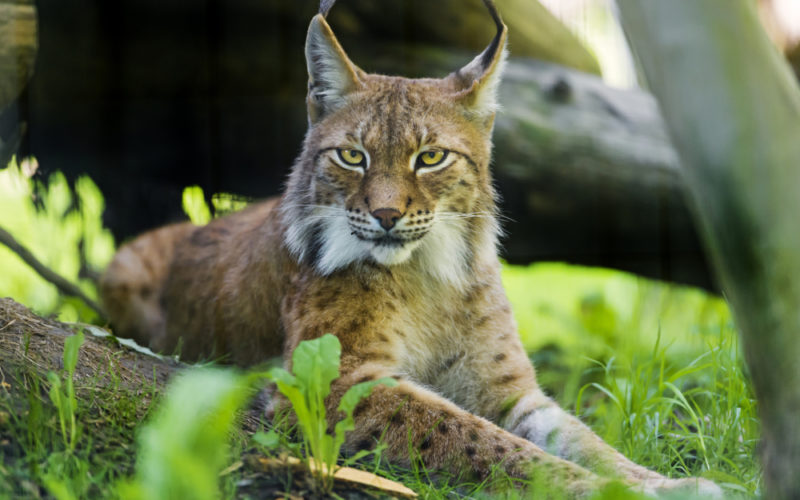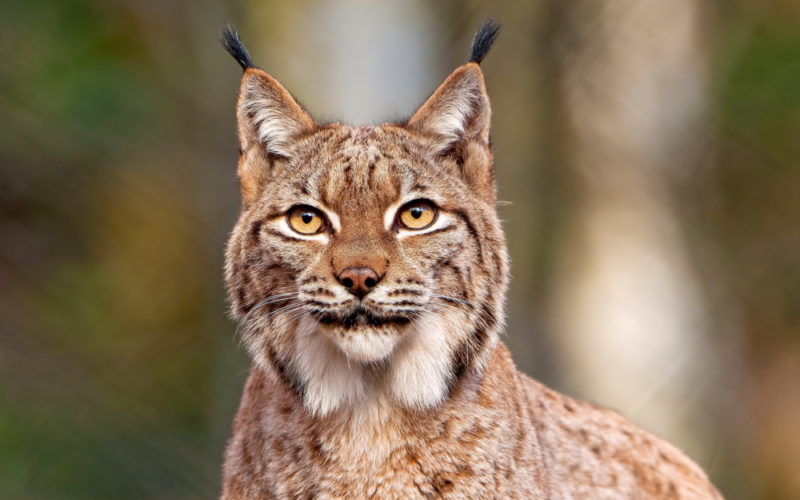Common Lynx - an animal that is gaining more and more popularity among people. Increasingly, these animals can be admired not only in the wild, but also in aviaries, where they are kept as pets. What are the main features of this magnificent predator?
Material Content:
Description and features of the species
Long-term observations of naturalists make it possible to give a complete and concrete description of the species of predators called the common trot.
- These animals in length reach about 1 m, height at the withers - 55 - 70 cm, and in weight - up to 20 kg.
- The tail of the beast is short, delicate ears adorn graceful tassels, which visually increase the organs of hearing in size.
- The paws of the beast, large and strong, make it easy to overtake and kill prey.
It is interesting. The tassels on the ears of the lynx were not created for decoration, as it might seem at first glance. With their help, the beast is able to track various sounds during the hunt, even very quiet ones.
- In addition to excellent hearing, the lynx is endowed with excellent vision and smell, as well as the ability to swim and climb trees and rocks.
- Lynx fur is very beautiful. In the upper part of the body, the color is reddish or piebald, and the abdomen is light. The entire surface of the body of the predator is dotted with specks, which helps the lynx to successfully disguise itself among the snows and between the trees.
Lifestyle & Habitat
Like most large wild animals, the lynx is prone to nocturnal lifestyle. This representative of the feline family is considered a lone beast, with the exception of the mating periods and those months that the female spends with the cubs.
Hunting mainly in the dark, the lynx can wait for prey in an ambush or hunt for a sneak. A large cat is waiting for a victim near a watering hole or rabbit trails.
Lynx lives in dense coniferous forests and in the taiga, but in some cases these cats can inhabit forest-tundra or forest-steppe. Lynx easily overcomes the height of rocks and trees, even the stormy waters of rivers are not afraid of it, since it can swim perfectly.
The presence of dense abundant wool allows the lynx to live in the cold snows of the Arctic. In Russia, this animal can be found in dense forests in the west right up to Sakhalin and Kamchatka. The habitat of the beast also includes Central Asia, the Caucasus and the Carpathians. In Europe, predators can be found in Finland, Scandinavia, the Czech Republic, Spain, and Poland.
Diet
Mostly lynx hunt hares, but are able to attack young wild boars, roe deer or Manchurian deer. Predators and martens, squirrels, birds are caught: black grouse, capercaillie, grouse.
In search of a victim, these big cats can overcome about 30 km per day. In especially hungry periods, animals can approach human habitats by killing livestock, as well as stray cats and dogs. The uneaten prey of a lynx is dug in the snow.
Did you know? Researchers and naturalists still can not explain the strange aggression manifested by the lynx towards foxes.
At any convenient opportunity, a large cat tries to gnaw a red-headed predator, moreover, never eating its meat, even in the most hungry periods. It is characteristic that lynxes are not good runners and attack prey suddenly, from behind or from above, and thereby relieve themselves of the need for further pursuit of the victim. But these predators will catch the fox long and hard, until they catch and destroy the red-haired enemy.
Breeding and breeding
In early March, Russia begins the period of trotting. It was at this time that females became very popular among males. So, one potential “bride” is accompanied by several suitors, fiercely fighting for her attention. The formed couples perform a very interesting greeting ceremony. “Loving” lynxes show attention to each other by licking their partner’s hair.
The pregnancy of the female lasts 65 - 70 days. In due time, from 2 to 5 kittens are born, whose weight is about 300 g. Lynx babies are deaf and blind, and therefore the mother for the first time reliably shelters their den under the roots of trees, in dug deep holes. Some females can build shelter in hollows of trees located low relative to the ground or in rocky crevices.
Lynx cubs open their eyes on day 12. Up to a month of age, a female feeds kittens with milk, gradually introducing meat into their diet. Both parents are engaged in the upbringing of young animals, protecting them from the attacks of predators and teaching them how to find food on their own. Females are considered to be mature at the age of 2 years, and males - a few months later.
Life span
Ordinary lynx - a kind of long-liver among individuals of its species. In captivity, all animals can live for about 17 years. For comparison, the red lynx lives about 12 years, the Canadian - about 14.
The life expectancy of captive predators increases, but here the common lynx loses to the Canadian and red lynx (24 years, 26 years and 32 years, respectively).
Enemies in the wild
The main enemies of the lynx in nature are considered to be other large representatives of the cat family: cougars, Canadian lynx and jaguars. Tigers, wolverines and wolf packs can fight for food with a lynx. Big cat lynxes in such cases often lose and leave the battlefield.
Small lynxes often become easy prey for other predators, including wolves and bears.
Interesting Facts
An incredibly beautiful and noble animal - a lynx, often becomes the object of close attention of a person.
Similar observations revealed several interesting facts about these animals:
- The inhabitants of ancient Greece believed that the lynx can see the world through objects. Moreover, the Greeks were confident that amber was nothing more than the frozen urine of this predator.
- In a tendency to play with its prey, the lynx is in no way inferior to a domestic cat. The only difference is that a large predator plays exclusively with a dead prey, since it kills the caught animals instantly.
- In 1960, Jan Hevelius, an astronomer, discovered a constellation in the starry sky, which is very difficult to detect. The researcher named him Lynx, claiming that in order to consider the cluster of these stars, one must have the same sharp vision as this predator.
- The ancient Slavs greatly revered the lynx, it was a kind of totem animal of this people. However, the inhabitants of Ancient Russia did not disdain the meat of this animal. True, princes and boyars exclusively treated them, because lynx meat was considered a delicacy. There is also a hypothesis, though not confirmed in any way, that the concept of Rus came precisely from the name of this beast.
- In one of the seaside zoos in 2018, a local cat named Masha fed a trotter.
- Maine coon cats are by no means the result of mating regular cats with a trot. And although the Maine's ears are also decorated with tassels, such a statement does not have any evidence base.
- Lynx is a peculiar symbol of the city of Gomel. Monument to the animal, cast in bronze, greets guests entering the territory of this geographical object.
The taste of lynx meat is rather highly appreciated, because this product resembles veal. However, in many countries of the world it is not accepted to use it for food purposes.
Red Book and Lynx
Man is one of the culprits of the strongest decline in the lynx population worldwide. Back in the twentieth century, in the territory of European countries, the number of these predators was reduced to literally several hundred. Poaching, deforestation and, as a result, a reduction in the food supply did not have the best effect on the number of lynxes.
So, in Germany, France and Switzerland, as a result of the extermination of predators, it was necessary to re-colonize the lynx in local forests. In the Balkans, there are only a few dozen individuals of these animals.
Many modern countries are taking various measures to preserve and increase the size of this magnificent creation. In particular, in Russia and Ukraine, these predators are listed in the Red Book.
Ordinary lynx is an animal that fascinates with its grace, beauty and nobleness of posture. These animals are wonderful swimmers, climbers and hunters. This predator never seeks meetings with humans and attacks the two-legged solely for self-defense.



















